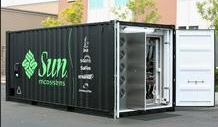Sun's data center in a box


Uses include faster datacenter deployment for startups and companies in need of space saving, more energy efficient capacity, and deployments in areas such as developing nations and remote locations. The containers can hold about 10 tons of equipment and withstand a six-inch drop, or nine times the force of gravity.
"Project Blackbox starts from the world's most broadly adopted industry standard, the shipping container, and asks -- how can we most efficiently create modular, lights-out datacenters from this base? The answer? With one-hundredth of the initial cost, one-fifth the cost per square foot, and with 20 percent more power efficiency, we can deliver an immense multiple of capacity and capability -- anywhere on earth," Sun CEO Jonathan Schwartz boasts in the press release.
Shankland quotes Jerald Murphy, a Robert Francis Group analyst, who said that the "better practice is to design things right the first time and plan things better." That's true, but not generally the case. The Blackbox continues Sun's push toward providing more utility-like computing as hosted infrastructure and now in a modular datacenter in a box. Murphy notes that datacenters in a box have been around for a few years, mainly for military use. I don't think that make Sun's efforts any less worthy. The Blackbox is slated for availability in mid-2007.
More to come from event at Sun today...
12:10 PST: Jonathan Schwartz in introducing the Blackbox now. He explained that Sun's ability to differentiate foot to foot is going to be relatively small in each category (software, servers, storage, services), but Sun's strategy is to focus what he called "core systems innovation," which is at the intersection of the four categories. Schwartz said that 30 to 40 percent of Sun's revenue is a derivative of GDP growth. A growing economy will not necessarily float Sun's boat, according to Schwartz's economics. Moore's Law will enable the marketplace to spend less, so IT spending will decline year-to-year. Sun is rolling out a new ERP system for only $8 million--wait six months it will be $5 million, he said.
The other portion of Sun is working to design next generation microprocessors that exceed Moore's Law, and can satisfy the hunger for efficient computing cycles for customers for whom Moore's law is helpful, but insufficient, Schwartz said. That includes companies like Google, salesforce.com, eBay, Citigroup, Verizon and any other company that riding the endless Internet curve. The problem, Schwartz outlined, is that power costs are out of control, companies are out of space, time to market is too long, they always need more performance and they don't have enough flexibility, physically and economically.
"We do not believe that existing datacenters will be shut down, are dead or an anachronism," Schwartz said. "We just bleieve that as customer continue to look at where to invest new dollars, the appetite for a $250 million datacenter that take three years to build is not an strong."
Sun CTO Greg Papadopolous (below left with Adam Yates of Applied Minds) steps through the set of innovations in the Blackbox shipping container, using a model replica. "This is a space that is designed for the machine, and is riding trends of lights out automation and high utilization, he said, and the "happy coincidence" of stuffing the parts into a precision-welded storage container that costs a few thousand dollars. For cooling, air flows in a circular path with fans and a heat exchanger for each rack. The air path is sealed so there aren't big humidty or particulate filtration concerns, Papadopolous said. A fully populated container requires a 60 ton chiller. Papadopolous also said that at the end of life of a Blackbox, Sun would take it back and recyle it.